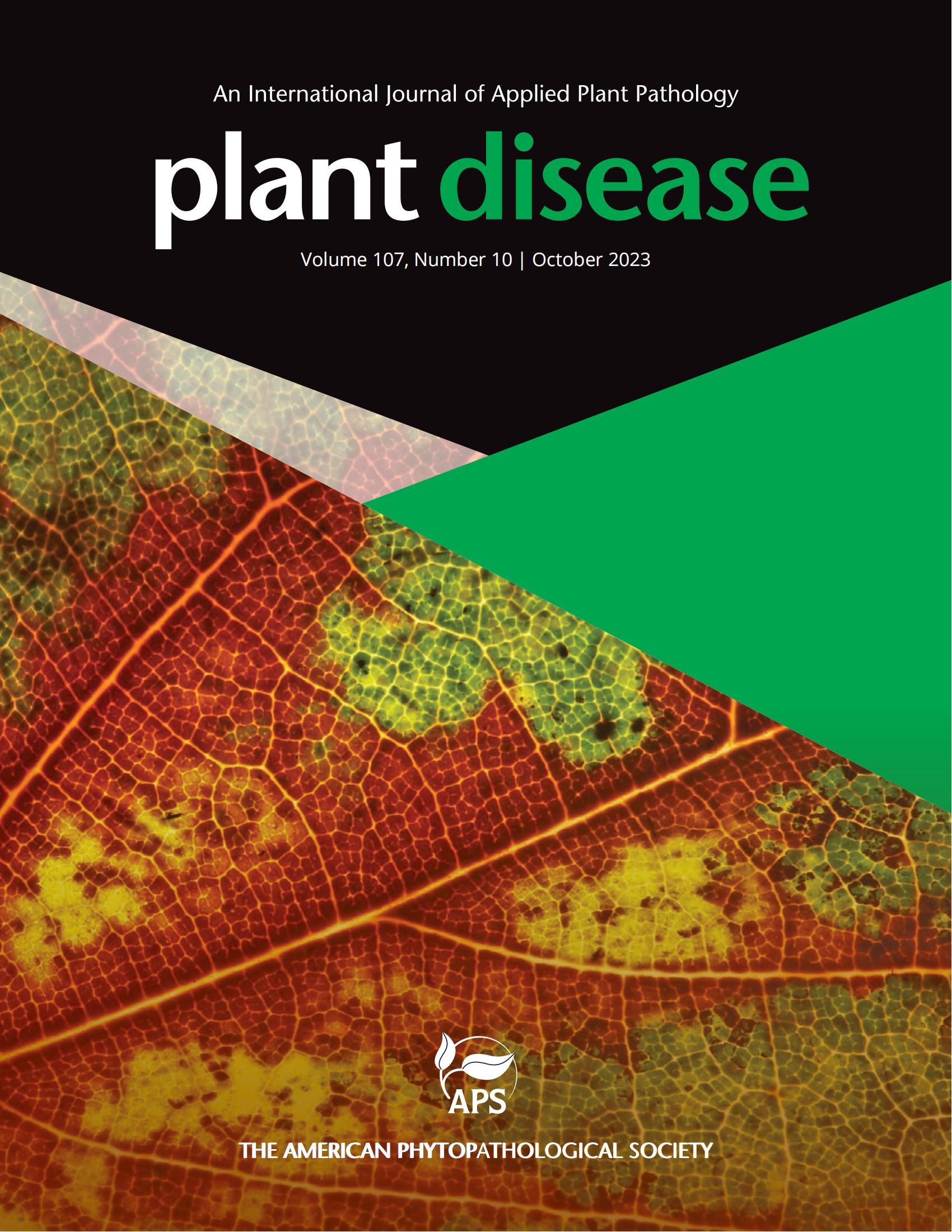高丛蓝莓茎枯病致病菌残倍虫初报。布里吉塔在智利中部的Maule地区。
摘要
高丛蓝莓(Vaccinium corymbosum L.)是智利重要的经济水果作物,总面积约为17,000公顷,即智利中部Maule地区(35°26'S, 71°40'W)的5,626公顷(www.odepa.cl, 2025)。茎枯萎病对智利的蓝莓生产构成威胁,发病率在15%至45%之间,归因于茎枯萎病科植物,包括杨梅新叶枯病、南叶枯病、非拟叶枯病和小叶枯病(Espinosa et al. 2009;Perez et al. 2014;Millas et al. 2023)。2023年1月,5丛12岁的蓝莓cv。来自Maule地区Longaví一个5公顷的商业种植园的Brigitta发病率为8%,已提交给Talca大学的水果病理学实验室。症状包括衰退、基底溃疡病、茎和甘蔗枯萎病(红色标记)(Polashok et al. 2017)。在横截面上,木质化茎有褐色的U或v形坏死或变色的硬组织。根据Díaz和Latorre(2014)对病茎进行消毒,将内部组织切成小块(3 x 3 mm),放置在马铃薯葡萄糖琼脂(PDA)和0.1% Igepal CO-630上。20℃黑暗培养5天后,将10个纯培养物转移到PDA上。在20°C条件下培养28天后,4株分离菌株菌落发育为白色至白灰色速生菌落,菌落中有大量的气生菌丝,菌落中有大量聚集的黑色菌丝。分生孢子为单细胞,透明,厚壁,椭球形至圆柱形,大小为(27.7-)25.1±1.5 (-22.4)x(14.7-) 13.2±1.3(-11.4)µm,长/宽比为1.9。为了确定物种水平,对3个分离株进行了扩增,并分别使用内部转录间隔区(ITS1-5.8 s - its2)、β -微管蛋白(tub)和翻译伸长因子1-α (TEF) DNA区域的ITS1/ITS4、Bt2a/Bt2b和EF1-728F/EF1-986R对引物进行测序(Alves et al., 2004;Dissanayake et al. 2015)。结果表明,该序列与D. mutila CBS 112553 ex型具有99%的相似性。残蝇分离株Bot-ara-1 ~ Bot-ara- 3序列已存入GenBank (ITS: PV032958 ~ PV032960;BT: PV037028 ~ PV037030;TEF: PV037031 ~ PV037033)。利用最大简约法将3株分离株与CBS 112553 ex型归为同一进化支。在田间(Longaví, Maule地区),利用5年cv蓝莓上的多致病性分离株(Bot-ara-1 ~ Bot-ara-3)进行致病性试验。七月的布丽吉塔。用剪刀修剪20根休眠茎(每丛5根)(茎尖),用微移液管将80µL分生孢子悬浮液(105个分生孢子/mL)放置在每根新鲜的剪枝上。另外,将20根休眠茎(40 cm长)用无菌软木蛀虫刺伤,然后用5天大的残木虱菌丝塞接种。用无菌水或无菌PDA培养基接种相同数量的茎作为对照。接种分生孢子悬浮液5个月后,茎部出现61 ~ 90mm长的坏死病变和枯死症状。三个月后,在接种菌丝塞的茎上测量了53至67毫米长的坏死灶。从所有样本(100%)中重新分离出残蝇,并利用ITS区域的形态特征和测序对残蝇进行重新鉴定。对照茎仍无症状。据我们所知,这是智利和世界范围内首次报道致病菌引起茎枯病的报告。Highbush blueberry (Vaccinium corymbosum L.) is an important economic fruit crop in Chile, with an approximate total area of 17,000 ha, i.e., 5,626 ha in the Maule region (35°26'S, 71°40'W), Central Chile (www.odepa.cl, 2025). Botryosphaeria stem blight is a threat to blueberry production in Chile, with incidence between 15 and 45%, attributed to Botryosphaeriaceae spp., including Neofusicoccum arbuti, N. australe, N. nonquaesitum, and N. parvum (Espinosa et al. 2009; Perez et al. 2014; Millas et al. 2023). In January 2023, five bushes of 12-year-old blueberry cv. Brigitta, from a commercial plantation, with and incidence of 8% was assessed across the 5 ha, in Longaví, Maule region, were submitted to the Fruit Pathology Lab at the University of Talca. Symptoms included decline, basal canker, stem and cane blight (red flagging) (Polashok et al. 2017). In cross-section, lignified stems have brown U or V-shaped necrotic or discolored hard tissues. Diseased stems were disinfected according to Díaz and Latorre (2014), and internal tissues were cut into small pieces (3 x 3 mm) and placed on potato dextrose agar (PDA) and 0.1% Igepal CO-630. After 5 days incubation at 20°C in darkness, 10 pure cultures were transferred to PDA. Four isolates developed white to white-grey fast-growing colonies with abundant aerial mycelium, and abundant aggregated black pycnidia after 28 days at 20°C. Conidia were one-cell, hyaline, thick-walled, ellipsoidal to cylindrical with a size of (27.7-) 25.1 ±1.5 (-22.4) x (14.7-) 13.2 ± 1.3 (-11.4) µm with a ratio 1.9 length/width. To determine the species level, three isolates were amplified and sequenced using ITS1/ITS4, Bt2a/Bt2b and EF1-728F/EF1-986R pair-primers of the internal transcribed spacer (ITS1-5.8S-ITS2) region, a beta-tubulin (tub), and the translation elongation factor 1-α (TEF) DNA regions, respectively (Alves et al., 2004; Dissanayake et al. 2015). The sequences showed a 99% similarity with sequences of D. mutila CBS 112553 ex-type. The sequences of D. mutila isolates Bot-ara-1 to Bot-ara 3 were deposited in GenBank (ITS: PV032958 to PV032960; BT: PV037028 to PV037030; TEF: PV037031 to PV037033). A phylogenetic tree, constructed using the maximum parsimony method using the concatenated sequences of the three regions, grouped the three isolates in the same clade with CBS 112553 ex-type. Pathogenicity tests were conducted in the field (Longaví, Maule region) using D. mutila isolates (Bot-ara-1 to Bot-ara-3) on blueberry of five-year-old cv. Brigitta in July. Twenty dormant stems (five per bush) were pruned (tip) with shears, and 80 µL of conidial suspension (105 conidia/mL) was placed on each fresh pruning using a micropipette. Additionally, 20 dormant stems (40 cm long) were wounded with a sterile cork borer and inoculated with mycelial plugs of D. mutila (5 days old). An equal number of stems inoculated with sterile water or sterile PDA media were used as controls. Necrotic lesions of 61 to 90 mm in length and dieback symptoms were observed after five months in stems inoculated with conidial suspension. Necrotic lesions of 53 to 67 mm in length were measured after three months on stems inoculated with mycelial plugs. D. mutila was reisolated from all samples (100%) and reidentified using morphological characteristics and sequencing of ITS region. Control stems remained symptomless. To our knowledge, this is the first report of D. mutila causing Botryosphaeria stem blight in Chile and worldwide.

 求助内容:
求助内容: 应助结果提醒方式:
应助结果提醒方式:


